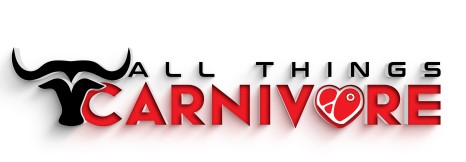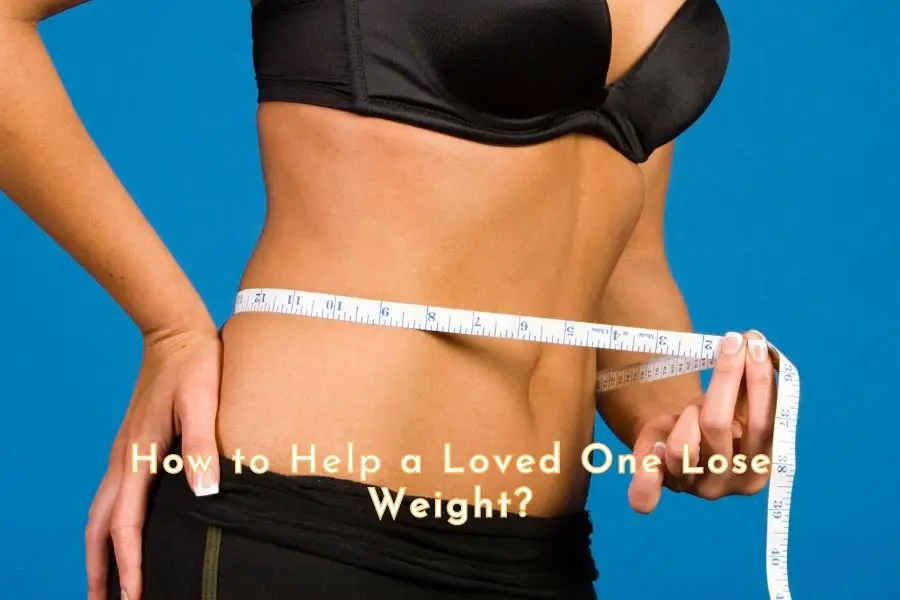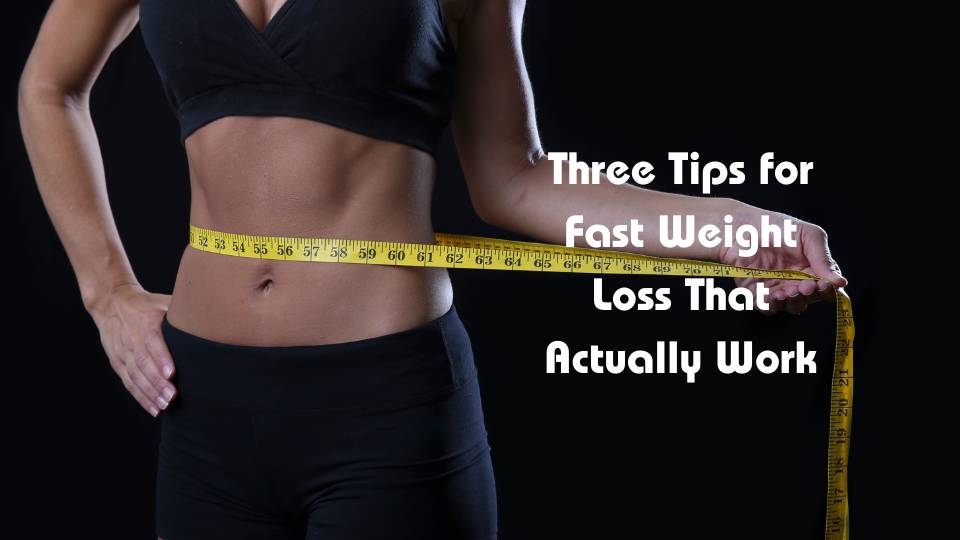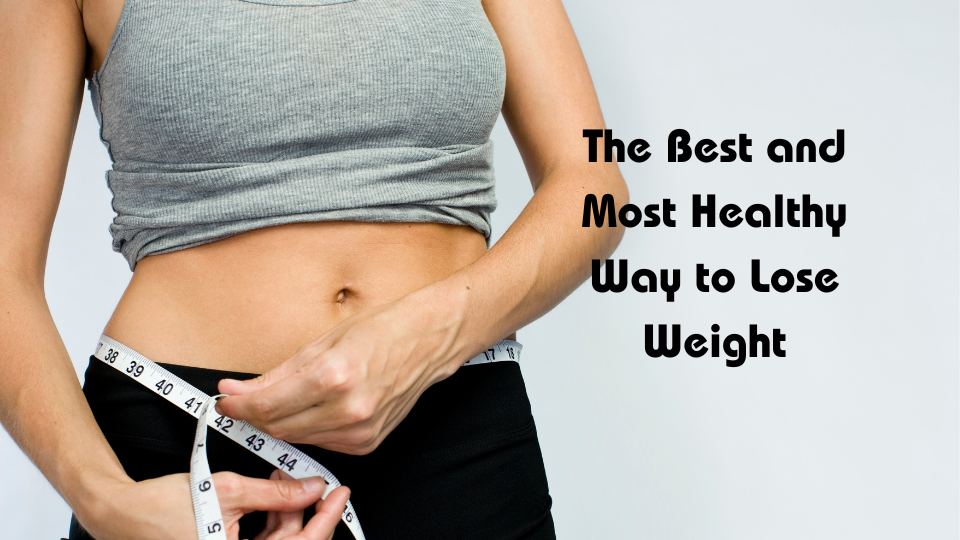If you want to lose weight fast in a healthy and sustainable way, you are in the right place. The carnivore diet is probably the best diet of all for healthy weight loss because its foods are nutrient-dense, free from plant anti-nutrients, and incredibly satiating.
Apart from a healthy diet, appropriate exercises, an active lifestyle, and having a positive mindset can also help with weight loss.
Because this is a big and complex topic, I will cover it in a four-part series. Hopefully, by the time you finish reading the series, you will get the whole picture of the key principles to lose weight that are science-based and can start implementing them and begin to gradually make positive changes to your health and general wellbeing.
Part 1: Healthy diet. The first part of the series, which is this post, covers the fundamentals of successful weight loss, how to ‘carnivore diet’ the right way to accelerate weight loss including what to eat, how much to eat, how often to eat, and when to eat. I also provide a sample meal plan to support weight loss
Part 2: Smart exercise. The second part of the series covers the types of exercises that are best to accelerate weight loss as well as how to increase your overall physical activity for weight loss and health benefits
Part 3: Positive mind. The third part of the series covers the link between stress and weight gain and how you can create a positive mindset to support weight loss
Part 4: Action plan. The final part of the series shows you how to put the principles that you learn in the previous three parts into an action plan to lose weight and improve your health.
Let’s buckle down and dive in.
Contents
- FUNDAMENTALS OF SUCCESSFUL WEIGHT LOSS
- HOW TO ‘CARNIVORE DIET’ TO LOSE WEIGHT FAST
- CARNIVORE DIET MEAL PLANS FOR WEIGHT LOSS
- CONCLUSION
FUNDAMENTALS OF SUCCESSFUL WEIGHT LOSS
The two basics fundamentals of successful weight loss are: i) finding a healthy diet that you are willing to stick to it for the rest of your life, and ii) creating a calorie deficit on this healthy diet.
1. Find a healthy diet that you are willing to stick to for the rest of your life
A healthy diet is a MUST for long term weight loss success
In my view, losing weight successfully means losing weight in a healthy way and keeping it off in the long run. Sure, you can lose weight with diet shakes, a prolonged lemon juice fast, or a month on the Twinkies diet. But those are unhealthy ways and short-term, and your weight will creep back up quickly once you revert back to the old lifestyle.
In order to lose weight in a healthy way and keep it off for good, you MUST get one thing right: find a healthy diet that helps you control your weight and with which you are happy to stay for the rest of your life.
Many people have reported losing weight on the carnivore diet but I’m certain that if they go back to their ‘before’ diet, they will gain the weight back effortlessly.
The carnivore diet is healthy and supportive of weight loss
In this post, I have talked in detail about why the carnivore diet is a healthy diet. In summary, based on available scientific evidence, the carnivore diet is a healthy diet because it can provide all nutrients that a human body ever needs. Historically, our ancestors not only survived but thrived on a mostly meat-based diet. Some modern-day groups who eat a largely meat-based diet also appear to be doing well health-wise.
In my view, the carnivore diet is also the best diet of all for healthy weight loss because carnivore diet foods are:
- Incredibly satiating. In the context of weight loss, this is especially helpful because it helps control your calorie intake and therefore control your weight. It is very hard to overeat on the carnivore diet. While you might be able to finish a whole pizza, a side of potato salad, and a bowl of chips without even trying, you will feel nauseous trying to stuff yourself with too much meat
- The most nutrient-dense foods you can ever eat. Animal-based foods provide you with complete proteins, good fats for energy, and all nutrients that your body ever needs (please read this post for an in-depth discussion of this topic)
- Free from anti-nutrients or plant toxins by definition. Animals have teeth to bite, beaks to peck, legs to run, wings to fly, poison to kill, or ways to disguise. Because plants are stuck to the ground, to defend themselves from predators, they produce toxins that are harmful when consumed. Plant toxins are present in their leaves, stems, flowers, seeds and roots. It is estimated that average Americans eat about 1.5 g of natural pesticides per person per day, which is about 10,000 times more than they eat of synthetic pesticide residues.[1]
- Low in carbohydrates. Apart from dairy and honey, there is only a negligible amount of carbohydrates in animal-source food. Carbohydrates, especially simple carbohydrates, stimulate the secretion of insulin which is a fat-storage hormone. Foods high in carbohydrates also have low satiety levels. Therefore, limiting carbohydrate consumption can help with your weight loss goal.
2. Create a calorie deficit on this healthy diet
Calorie deficit is the key
When you say you want to lose weight, you probably mean you want to lose the excess energy that your body has been storing as fat, not muscles.
To reduce this fat storage, you will have to force your body to tap into this energy reserve and your body will only do that when there is a calorie deficit, i.e. the number of calories coming in is less than the number of calories burnt.
Despite some recent arguments that calorie counting and calorie deficit doesn’t matter, I still believe when it comes to weight loss, the fundamental law of biophysics holds: your body needs the energy to operate and when it doesn’t get sufficient energy from an external source, it will have to use up the reserve, i.e. burn fat.
To prove the point that in weight loss, a calorie deficit is what matters most, in 2010, Mark Haub, a professor of human nutrition at Kansas State University, lived on a diet of Twinkies (a popular American cream-filled sponge cake), nutty bars, powdered donuts, Doritos chips, sugary cereals and Oreos for ten weeks and lost 27lb (12.2kg).[2]
This is of course neither healthy nor sustainable, but if you want to ignore your health and focus solely on the number on the scale, it still works.
How to create a calorie deficit
You can create a calorie deficit by either:
- reducing the number of calories you consume, or
- increasing your calorie expenditure.
However, if you want to lose weight fast, you should tackle both. In the following sections, we will explore strategies within the context of the carnivore diet to help you achieve that.
HOW TO ‘CARNIVORE DIET’ TO LOSE WEIGHT FAST
In this section, we will look at the specifics of the carnivore diet to help you lose weight fast.
If you’ve already been on the carnivore diet for a while, adapted to this way of eating, and just want some tips to become leaner or lose the last few pounds, read on.
If you are new to the carnivore diet, it is highly recommended that you read this post first which is a step-by-step guide written especially for people like you, BEFORE you try to lose weight. Your health is your most important asset and should be your number one priority. Weight loss will follow, possibly without too much work if you get the first priority right.
It is highly likely that you will naturally lose weight on this diet as many people have experienced before.[3] You only need the tips below if you’ve fully adapted to the carnivore diet for a period of time but find it hard to lose the last few pounds.
1. What to eat to lose weight fast
To lose weight fast but in a healthy way, you need to eat food that is nutrient-dense, satiating, and low in calories. The best foods that meet these criteria on the carnivore diet are leaner cuts of meat, preferably ruminant meat like beef, lamb, bison, and goat, their organ meats, eggs, and seafood. Dairy products should be eliminated or eaten very sparingly.
The reasons for these recommendations are explained in detail below.
All animal-source foods are nutrient-dense
While controlling the calorie intake, you need to keep your body well-nourished and there is no better way to do it than feeding yourself animal source foods.
Animal source foods are incredibly nutritious. They are a good source of complete proteins and energy while rich in essential vitamins and minerals. They are also highly bio-available and free from natural pesticides which can be found in abundance in plant foods.[4]
Lean meat is low in calories
As can be seen in the table below, animal fat has 4 to 8 times more calories than lean meat. Therefore, it makes sense to opt for leaner cuts of meat to control your calorie intake if you try to lose weight.

Proteins are essential for muscle synthesis so it’s important to maintain adequate protein intake to make sure when you lose weight, you are actually losing fat reserve rather than muscle mass.
Furthermore, the thermic effect of food or the amount of energy needed to digest lean meat, which consists of mostly proteins, is around 15% to 30% compared to only about 0% to 3% needed to digest fat.[6]
It is, therefore, obvious that lean meat will help with lowering net calorie intake, lose fat while maintaining muscle mass.
However, eating lean meat only is not recommended because fat is an essential energy source on the carnivore diet.
You definitely can lose weight on a high protein, high fat, and low carb diet, but if you go high protein, moderate fat and low carb, you can lose weight a little faster.
If you have been eating a lot of fatty meats like strip steak, rib eye, budget ground beef, pork belly, pork ribs, chicken wings, and chicken drumsticks with skin on, try to switch just one meal to leaner cuts at first. Also, avoid deliberately adding fat to your meals, e.g. suet, butter, and rendered fat.
Stay with this for at least a couple of weeks and record your weight loss progress and how you are feeling in general before cutting down your fat intake further.
Remember, listen to your body and don’t go for lean meat only which will likely make you feel sick. When Vilhjalmur Stefansson was put on a one-year of meat-only diet as an experiment, they first fed him lean meat only. On the third day of this lean meat diet, he developed nausea and diarrhea. When they fed him meat with fat on, he quickly recovered.
If you just aim for the average cuts of meat and don’t deliberately add fat to your meals, you are doing well already and will definitely lose weight.
Choose ruminants over pork and poultry
Although you should go for leaner cuts of meat to support weight loss, as mentioned above, you still need fat which is the main source of energy on the carnivore diet. The best kind of fat is ruminant fats because farmed ruminants are better raised and have better fat profiles than pork and poultry.
Around 90% of farmed animals today live in factory farms. While farmed pigs and poultry are most likely to spend their entire life indoors and are fed an unnatural diet, ruminants like cows, sheep and goats are mostly raised outdoors and are fed a diet closer to their natural diet.[7]
Furthermore, ruminant meats tend to have a lower level of polyunsaturated fat and better omega 6 to omega 3 ratios than pork and poultry. Polyunsaturated fats, especially omega 6, have been linked to increased cancer risk, suppression of the immune system, lowering good cholesterol (HDL-C) and increasing the susceptibility of LDL to oxidation.[8]
As can be seen in the table below, beef fat and lamb fat have omega 6 to omega 3 ratios of 1.4 to 2.1 compared to 10.2 and 19.5 for pork and chicken fat respectively.
Our ancestors are thought to have consumed an omega 6 to omega 3 ratio of approximately 1:1. [9] Ruminant fats’ ratios, therefore, are much closer to this ideal ratio than pork and poultry.
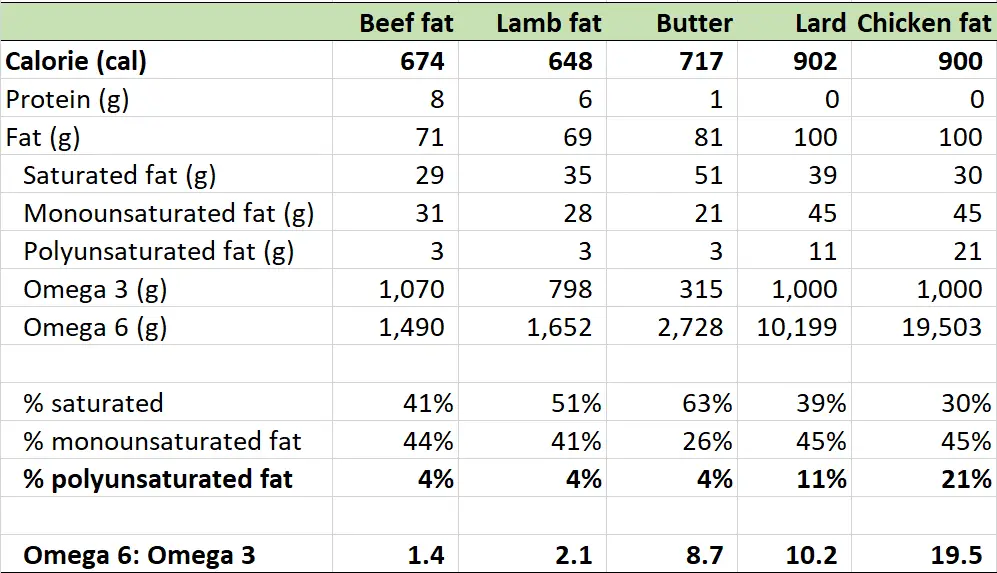
Organ meats, eggs and seafood are super nutritious but also low in calories
As can be seen in the table below, organ meats, eggs, and seafood are incredibly nutritious but also low in calories. Apart from some fatty fish, their calorie contents are comparable to those of lean meats and should be added regularly in small quantities.
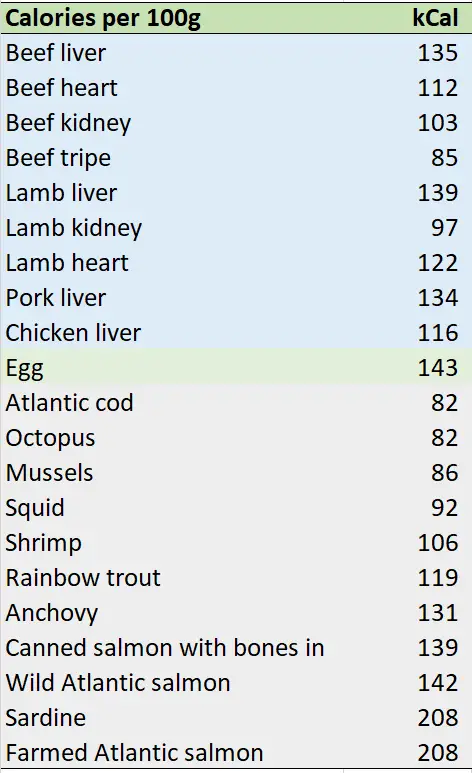
Dairy products should be eliminated or eaten sparingly
Milk is a nutritious and complete food. It has a perfect ratio of protein, carbohydrate, and fat and is rich in many essential nutrients. It has everything that an infant mammal needs to grow into a young healthy animal. For a more detailed discussion about milk on the carnivore diet, please read this post.
However, milk is intended for a growing animal, if you are done growing, it is best to avoid it or have it sparingly.
Dairy products made from milk are high in protein and fat and rich in calcium but also very high in calories, as can be seen from the table below. They are also not as satiating as lean meat. Therefore, depending on how aggressive you want to drop weight, you may want to cut these out completely or only eat on rare occasions.
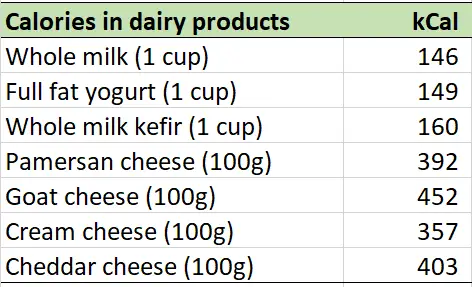
Honey and carnivore treats should be avoided
Honey has many health benefits, however, it is mostly sugar. Sugar will trigger the release of insulin, a fat-storage hormone, which is the opposite of what you want. Sugar also has a low satiety level and it is very easy to overeat.
Common carnivore treats like bacon, pork crackling, carnivore ice-cream and smoothies should also be avoided because they are generally high in fat and high in calories.
When you want to lose weight, the best carnivore treats are those made from lean meat like beef jerky or you can make dry shredded meat which is healthy and low in calories at the same time. Here, here and here are links to super easy recipes to make your own shredded beef, chicken, and pork.
Carnivore diet food list for weight loss
In summary, based on the discussion above, to support weight loss on the carnivore diet, the following are what you should and should not eat.
| FOOD TO EAT TO SUPPORT WEIGHT LOSS: |
| Leaner cuts of beef, lamb, bison, goat, roo, deer (but not fat-free) |
| Lean pork and poultry |
| Liver |
| Heart |
| Kidney |
| Tongue |
| Tripe |
| Other organ meats |
| Eggs |
| Seafood |
| FOOD TO AVOID TO SUPPORT WEIGHT LOSS: |
| Added animal fat |
| Rendered fat |
| Butter |
| Dairy |
| Honey |
| Carnivore snacks and treats e.g. bacon, pork crackling, carnivore ice cream, and smoothies |
2. How much to eat to support weight loss
As discussed in the above section, it’s best to focus on eating nutrient-dense foods that are low in calories. Eating mostly lean meats, organ meats, eggs, and seafood should hopefully do most of the work to get you your desired body composition.
However, if you would like to be a little more aggressive in losing the excess fat reserve, cutting down your calorie intake by reducing food quantity will help. But first, you will need to know how much you are currently eating.
A simple way to find out is to keep a food diary for one to two weeks and note down the following:
- the timing of your meals
- types of food you eat (beef, pork, chicken, eggs, etc.)
- their approximate lean/fat ratio
- how much you eat approximately in grams or pounds a day.
Here is a 7-day food diary template that you can just print out and start straight away.
Based on your food diary, if you think you can cut down a little in terms of food quantity, try to cut down on the last meal of the day. Towards the end of the day, you are likely to be less active and if you eat a little less on the last meal of the day, it is unlikely to affect you much. I usually don’t eat dinner and if I am a bit more active than usual during the second half of the day, I may feel a little hungry in the evening or at night for a very short time only and for most of the time can carry on as usual.
If you feel you are at your threshold and can’t reduce the quantity of your food intake, please don’t. Whatever you do, don’t count calories, and don’t starve yourself. Going around feeling hungry all day is much worse than carrying a bit of extra fat reserve on your body.
Apart from focusing on nutrient-dense and low-calorie foods, there are other strategies discussed below that can help you with achieving your dream body composition.
3. How often to eat to support weight loss
To support weight loss on the carnivore diet, you should eat as less frequently as possible and practice fasting regularly.
It is commonly believed that having many small meals spread out throughout the day will help with weight loss because it helps keep your metabolism up while controlling your blood sugar.
However, this is a pure myth. Studies have found that there is no difference in energy expenditure between nibbling and gorging nor does high-frequency meals support weight loss.[13, 14]
In contrast, it is found that low-frequency meals coupled with intermittent fasting are better for health and weight loss.[15, 16] In particular:
A regular meal pattern including breakfast consumption, consuming a higher proportion of energy early in the day, reduced meal frequency (i.e., 2–3 meals/day), and regular fasting periods may provide physiological benefits such as reduced inflammation, improved circadian rhythmicity, increased autophagy and stress resistance, and modulation of the gut microbiota

The above eating pattern is based on Paoli et al (2019)’s study.
While you can certainly start with 2-3 meals a day, my personal experience and the experience of many people on the carnivore diet are that once you are fully adapted to the carnivore diet, you don’t need to eat more than 1 to 2 times a day.
This way of eating is also more consistent with how our ancestors would have eaten for millions of years.
Our ancestors were unlikely to have had access to three square meals a day every day. Sometimes they would have feasted when food was in abundance and sometimes they would have been forced to fast when they were unsuccessful with their hunts.
4. When to eat to support weight loss
Research has found that eating patterns aligning with circadian rhythms help with weight loss and metabolic health.[18, 19]
Your body’s circadian rhythm is the internal 24-hour clock running in the background of your brain and regulates the sleep and wake cycle at regular intervals.[20]
Aligning food consumption with your circadian rhythm means not eating late and allowing your body at least 14 to 16 hours of fasting.
This translates into main food intake at breakfast and lunchtime, no dinner, or a very light and early dinner. Eating dinner right before bedtime affects your sleep. In addition, because your metabolism slows down at night, late meals can lead to an increase in fat storage and waist circumference.
This strategy also makes sense from an evolutionary perspective. It would have been difficult to hunt later during the day or at night and our ancestors were unlikely to eat when it was already dark.
Sample carnivore diet meal plan to lose weight
| Meal 1 | Meal 2 | |
|---|---|---|
| Day 1 | Beefsteak + bone broth | Slow-cooked lamb shank + organ (seared liver) |
| Day 2 | Ground beef + eggs + bone broth | Pork chop +organ (grilled bone marrow) |
| Day 3 | Lean chicken roast +small fish with bones in + bone broth | Seared beef steak + organ (oxtail stew) |
| Day 4 | Meatloaf + bone broth | Pan-fry fish +organ (pan-fry kidney) |
| Day 5 | Butterflied lamb leg + bone broth | Ground meat + organ (seared liver) |
| Day 6 | Chuck roast + bone broth | Beef & lamb stew +organ (stir-fry beef heart) |
| Day 7 | Pork steak + Small fish with bones in + bone broth | Seared beef steak + organ meat (seared liver) |
Conclusion
You will lose weight naturally on the carnivore diet. To accelerate weight loss further, you can adopt the following strategies:
- What to eat: Eat leaner cuts of meat, preferably ruminant meat like beef, lamb, bison, goat, their organ meats, eggs, and seafood. Avoid added fat, butter, honey, dairy products, and carnivore treats
- How much to eat: Start with current food quantity and cut down only to the extent that you are comfortable with
- How often to eat: Eat 1 to 2 meals a day to satiety and don’t snack in between. Practice fasting regularly
- When to eat: Eat early, preferably before 16:00.
In the next post of this series, I will address the question of how to exercise to support weight loss.
Disclaimer: The information in this post is for reference purposes only and not intended to constitute or replace professional medical advice. Please consult a qualified medical professional before making any changes to your diet or lifestyle.
